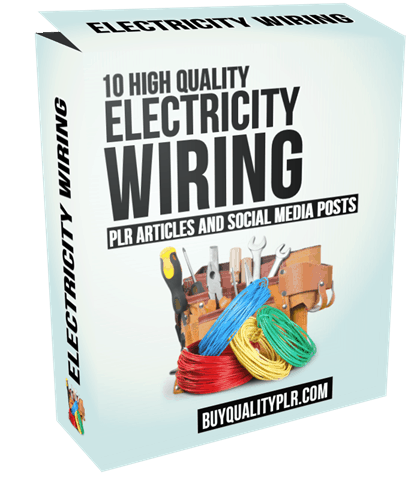
10 High Quality Home Electricity Wiring PLR Articles and Social Posts
in Home Exterior PLR Articles , Home Improvement PLR , Home Improvement PLR Articles , PLR Article Packs , PLR Articles , Private Label Rights ProductsChoose Your Desired Option(s)
has been added to your cart!
have been added to your cart!
#wiring #homeelectricitywiring #electricitywiring #commonwiringissues #electricalcircuits #colorcodedwires #faultywiring #differentvoltage #electricalshock #wiringissues #wiringplr #electricitywiringplr
10 High Quality Home Electricity Wiring PLR Articles and Social Media Posts – Featuring Over 5 800 Words of Done-For-You Evergreen Home Improvement Content.
Attention: Home Improvement, Do It Yourself and Home Remodeling Marketers
How Would You Like To Get Access to High Quality Content Focusing On The Evergreen and Profitable Topic:
Home Electricity Wiring !!
Dear Home Improvement marketer, When it comes to home improvement and home DIY searches, the Electricity Wiring is one of the most searched-for topics online.
It’s safe to say that Electricity Wiring has spawned an entire industry of blogs, courses, books and products.
This is where our 10 High Quality Electricity Wiring PLR Articles can help you. Our 10 High Quality Electricity Wiring PLR Articles is well written and well researched by professional copywriters and ready to be use in your online business.
has been added to your cart!
have been added to your cart!
Introducing The…
10 High Quality Home Electricity Wiring PLR Articles

Featuring Over 5800 Words of Done-For-You Home Electricity Wiring PLR Article Ready To Be Used In Your Business!
Working on a home wiring project can be a shocking experience, literally and financially. Having a basic understanding of a home’s wiring is important for the homeowner wanting to replace or repair electrical items in the home. Don’t let your readers go into this DIY project blindly.
This bundle includes 10 articles (500-650 words each) for those interested in repairing or replacing electrical items within the home. You also receive a pre-written social media post for each article so you can promote your content on places like Twitter and Facebook.
Here’s a breakdown of the Home Electricity Wiring PLR Article Titles and Word Counts for each article:
- Explanation of Different Voltage Needs (618 words)
- Avoiding Electrical Circuit Overloads (600 words)
- Common Wiring Issues in Older Homes (604 words)
- The Hidden Costs of Faulty Wiring (548 words)
- How to Ensure You’re Grounded (658 words)
- How to Test Electrical Circuits before You Start Working (606 words)
- Signs You Might Have Wiring Issues (559 words)
- Understanding the Color Coded Wires (420 words)
- How to Prevent Electrical Shock in the Home (589 words)
- Wiring Issues to Check For When Purchasing a Home (606 words)
Here’s a screenshot inside the PLR Home Electricity Wiring Articles Folder:


Here’s a sample of one of the Home Electricity Wiring PLR articles:
An Explanation of Different Voltage Needs
Most of the items that are plugged into your household wiring require 120 volt service. Those items will include, but certainly not be limited to, electronics (TV, computer, sound systems), lamps, small kitchen appliances, and bathroom accessories such as hair dryers and curling irons.
The few things in your house that require 240 volt service include your kitchen stove or range, your electric hot water heater and your electric clothes dryer.
The big difference between the items requiring 120 volt service and those requiring 240 volt service is the power consumption – the wattage – of the items.
Lamps and light fixtures might require anywhere from 60 to 400 or more watts, depending on the size and number of light bulbs used. A typical laptop computer is about a 90 watt appliance. A large LED flat-screen TV will be about 800 watts. Then you have micro-wave ovens, typically in the 1,000 to 1,500 watt range, and toward the top end of typical household small appliances are hair dryers, at 1,500 to 2,000 watts.
At the top end of energy consumers in your home are electric ranges and ovens, clothes dryers and hot water heaters. Their requirements start well above the top end of the requirements of other home appliances. If you are using your oven while cooking on all four burners of a 4-burner range, you are drawing about 11,500 watts. An electric hot water heater will consume about 5,500 watts, and the clothes dryer uses up to 5,000. These high-wattage appliances are on 240 volt circuits. Note that all of these high-wattage appliances have large heating elements that require a lot of energy to produce the heat.
So why do these high-wattage devices require higher voltage? Any explanation requires a (very) little foray into some technical stuff about electricity. The three elements in electricity that we need to look at are amps, volts and watts, and there is a common analogy to help clarify them. In the analogy, the picture is a water hose. Amperage is represented by the size (diameter) of the hose; Voltage is represented by the water pressure; and wattage is represented by the volume of water emerging from the hose.
If we need to increase the water emerging (watts) we can increase either the water pressure (voltage) or the size of the hose (amperage). By increasing the voltage we can increase the watts available to drive devices.
By the way, if you’re concerned about the cost of using higher voltage, don’t be. There are two different ways that cost comes into consideration on this issue. Regarding one of them, the change in voltage makes no difference at all. On the other, the higher voltage presents lower costs.
The area where the voltage makes no difference at all is in your utility costs. You pay your electric bill based on the kilowatt hours you use (the number of watts of power you consumed and the amount of time you were consuming them). Since only the time that you are using electrical devices effects that number, the voltage is irrelevant to your uitility bills.
Note: The above content is just a snippet of one of the articles
has been added to your cart!
have been added to your cart!
We will only be selling 50 copies of this Home Electricity Wiring PLR Articles Pack.
Grab your PLR license to this high quality Home Electricity Wiring PLR content for only $9.99 and get instant download access via email.
Here are the PLR Licence Terms:
You can add the articles or content to an ebook or product that you plan to sell or give away for individual use.
You can use the content to build your email list.
You can modify the content by removing, adding or otherwise editing to suit your needs.
You can use the content on your websites, blogs, newsletters or anywhere you publish content.
You can add your affiliate links, product links, Adsense and other ad code.
You can bundle the content into a viral report, free ebook, product or bonus for your customers.
You can charge for access to read this content. For example, a paid ebook, membership site or other paid access content.
You can translate it into another language and resell with personal use rights.
You can add the content as a autoresponder email series.
What you CANNOT do:
1 – You CANNOT sell this product as your own PLR or in your PLR store.
2 – You CANNOT submit any of the content provided by Buy Quality PLR to reprint article directories or other websites which accept reprint content even if you have edited or reworded the content.
Why? Because many article directories won’t take PLR articles. If everyone started submitting similarly written articles to these directories it wouldn’t be fair for the directory owners, their users or our members. Be fair to everyone involved and don’t do it, even if you feel you’ve edited or reworded the article.
3 – You CANNOT sell this product with a PLR, MRR or Resell Rights License.
Legal Disclaimer:
This license is Non – Transferrable; meaning you cannot give these same rights away. If you want to sell rights to your customers; pay close attention to the license below. We closely monitor vendors that sell the product and take legal violations seriously.
Share Now!












